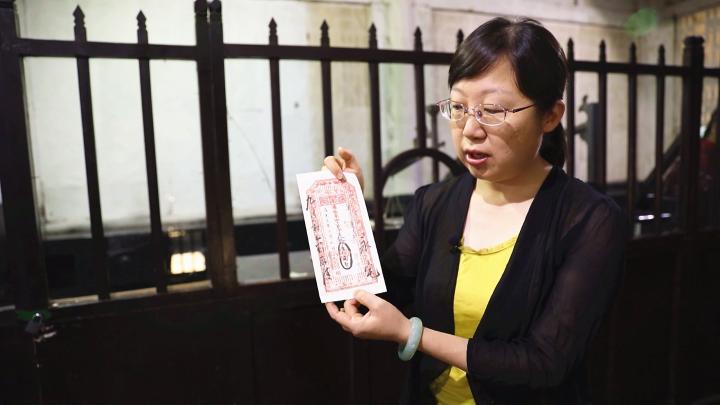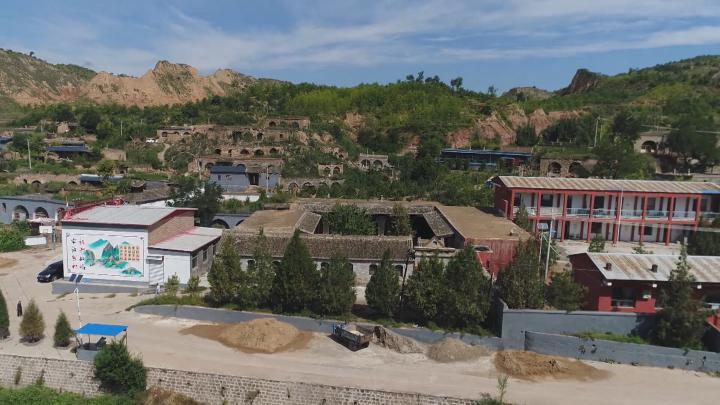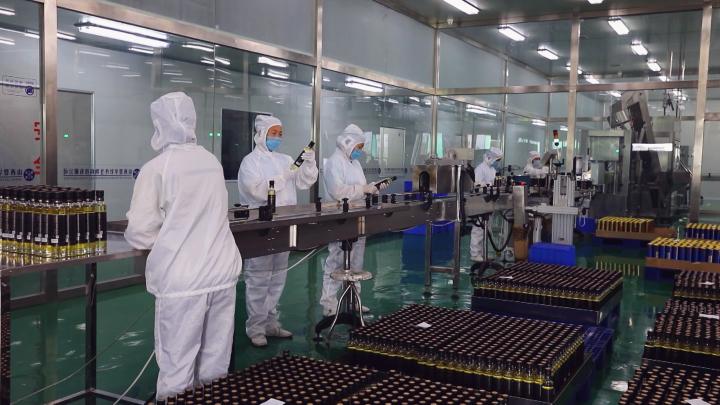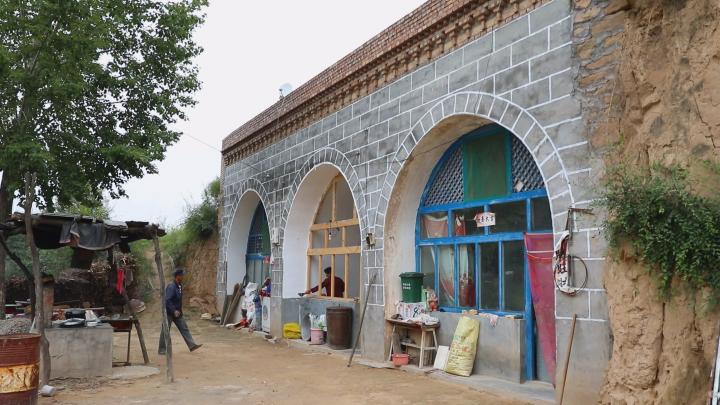Xinglongyi Inn, one of many hotels adapted from century-old buildings in the UNESCO heritage-listed city of Pingyao, north China's Shanxi Province, is rated 4.5 points on Tripadvisor, the world's leading travel platform.
"From this house, my ancestors developed tea trade with businesspeople from as far as Russia in the Qing Dynasty. But locals seldom saw foreigners here in the old time. Nowadays, half of my guests are from Europe," said Zhao Xiaohong, owner of the inn.
When she inherited the house, it was dilapidated as a deserted silk shop. She restored it to keep the building's original appearance and renovated the interior into separate hotel rooms.
"The buildings are well protected. The hostess is nice and can speak English. The best of all is the courtyard, a perfect place for tea-drinking and reading," said Bart Johannes, a hotel guest from the Netherlands.

Xinhua reporter shows a paper bill developed by China's first private bank Rishengchang for long-distance exchange of gold and silver in late Qing Dynasty. (Xinhua/Zhao Yang)
Pingyao, the ancient walled city built to its current form in the 14th century, was named a world heritage by UNESCO in 1997.
The city put itself on the map in the 19th century as China's financial center. Banks flourished as Shanxi merchants expanded their businesses across the country and abroad.
"In its heyday, Pingyao hosted 22 bank centers with outlets set up in 69 cities and townships nationwide. They controlled nearly half of the money in the country," said Gao Chunping, a researcher with the Shanxi Academy of Social Sciences.
Gao said many asked why the prototype of China's banking appeared in such a landlocked hinterland. But it was exactly because its land is barren, people had to reach out for business that could earn them living, such as doing trade and finance.
With land erosion by the banks of the Yellow River, known as the Loess Plateau, and desolate mountains, Shanxi has harsh natural conditions, compared to the country's eastern plain areas.
Pingyao's golden days from the prosperity of trade and finance did not last. In the early 20th century, the banks collapsed one after the other, as the Qing dynasty fell and an influx of foreign banks followed, and soon the country fell into war.
Despite the twist and turns, Shanxi's financial sector has helped lay a foundation for the country's banking.

The site of the Northwest Farmers Bank in Shanxi Province (Xinhua/Zhao Yang)
The province witnessed the establishment of two predecessors of China's central bank during the anti-Japanese aggression war. With the two banks, the Communist Party of China (CPC) was able to issue currencies in the 1940s before the founding of New China in 1949. The banks later merged into the People's Bank of China, China's central bank.
But it is Shanxi's rich coal resource or so-called "black gold" that has brought a more profound impact on national development.
Since the founding of the People's Republic of China, the province has produced more than 19 billion tonnes of raw coal and sent it to 26 Chinese provinces, autonomous regions, and municipalities to fuel local economic development. As the saying goes, half of the lamps in China were illuminated by thermal power plants using coal from Shanxi.
In 2018, Shanxi's raw coal output was 893 million tonnes, more than 340 times the output in 1949.
However, the fast growth has left "scars." Coal mining deteriorated the destruction of vegetation coverage and was blamed for the worst smog occurrence in China. There is also a subsidence area of at least 3,000 sq km as a result of coal mining in the province, which also triggered disruption of ground rivers.

Anti-poverty campaigns put a "green coat" on barren hills on the Loess Plateau. (Xinhua/Zhao Yang)
Shanxi was forced to change its economic development model. In 2009, the provincial government launched an energy revolution to reverse the chaos of coal mining and transform to green development.
The coal-rich province has closed 88 coal mines and reduced 88.41 million tonnes of overcapacity from 2016 to 2018, leading the country in coal capacity cut.
In 2018, the provincial government spent 80 percent of its fiscal expenditure, or more than 400 billion yuan (56 billion U.S. dollars), in the sectors of environment protection, education, poverty alleviation, and transportation.
Wang Ping was laid off when Shigejie Coal Mine was shut down in 2016, amid Shanxi's efforts to cut outdated coal mines.
Lu'an Group, the owner of the coal mine, transferred her to work in a biotechnology company owned by the group.
At first, she was reluctant to go, since her family all worked in the coal mine. But soon she found the benefits of the new company.
"The company develops food and cosmetics with peony seed oil. I work in a packaging factory. The environment is so clean, which is in big contrast to the coal shaft, and my monthly income increased by nearly 1,000 yuan," she said.

The packaging workshop of products made with peony seed oil at the Shanxi Lu'an Shigejie Zhihua Biotechnology Co. Ltd. (Xinhua/Zhao Yang)
Feng Guobao, board chairman of Shanxi Lu'an Shigejie Zhihua Biotechnology Co. Ltd., said that developing peony seed oil was originally one of Lu'an Group's initiatives in assisting poverty relief in the mountain areas. But over time it has become the most successful program for Lu'an to diversify its business structure.
The company now boasts one of China's largest seed oil production capacities with a peony-planting base of 300,000 mu (20,000 hectares).
"We have exported 1,500 km of peony seed oil to the Republic of Korea this year," Feng said.
He said in the mountainous areas, the land is poor. Peony planting is more effective than grain planting, and it also saves labor.
"The ecology here is fragile. Only ecological agriculture is environmentally friendly," he said.
In the past 20 years, the local government and leading enterprises like Lu'an have initiated programs, helping farmers find a fortune in the poor mountainous areas, while restoring the ecological environment.
Instead of depending heavily on mineral resources, locals began to plant economic trees and herbs. They have turned 1.82 million hectares of reclaimed land back to mountain forests, putting a "green coat" on the barren hills.
Sun Ping'er, a 59-year-old man from Mengjiaping Village of Xingxian County in the Loess Plateau, said locals traditionally lived in cave dwellings dug in loess slopes, which were humid, dark, and dangerous.
"When I was young, our family of five lived in such a cave house. We only had two meals a day in winter," he said.
Two years ago, Sun and his wife joined a rural cooperative specializing in afforestation for poverty alleviation. They earned more than 50,000 yuan last year by planting high-value fruit trees, which not only lifted him out of poverty but also enabled him to enlarge and consolidate his cave dwellings with bricks and concrete.

The refurbished cave-dwelling house of Sun Ping'er, a resident on the Loess Plateau, who has just shaken off poverty. (Xinhua/Zhao Yang)
The refurbishment has made the cave-dwelling spacious and safe. He spent 10,000 yuan for the building, which he could not have imagined 10 years ago.
By October, 41 counties in Shanxi had been lifted out of poverty, although the poverty relief campaign in the province had been considered quite challenging.
"The government is helping the poor, and we should work hard to help ourselves," Sun said.

